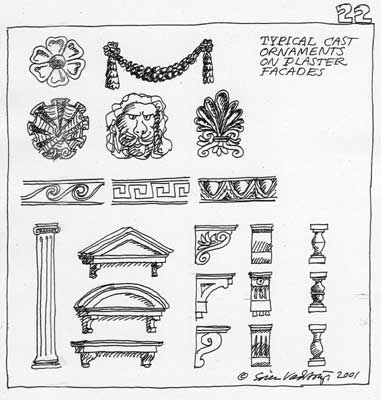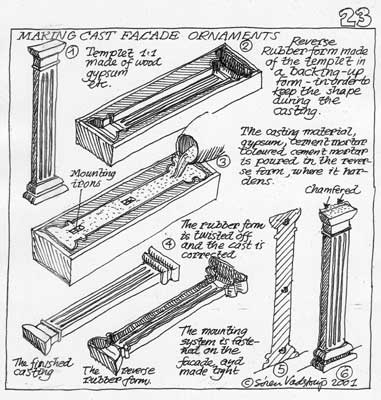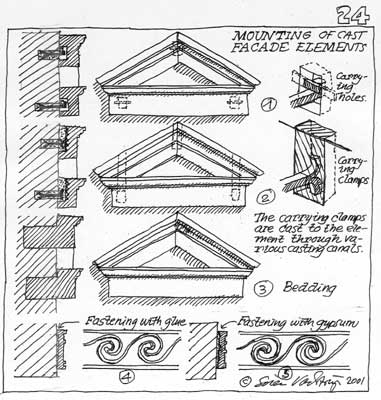Working
Techniques and Repair Methods for Plaster Decorations on Facades
By: Søren Vadstrup
8. Cast decorations
in plaster, gypsum or cement on facades

Quite a lot of the decorations on
plaster facades are cast in Portland Cement mortar, gypsum or other specially
mixed materials and thereafter mounted to the plaster surface.
Portland cement is created among
other things to suite this purpose, but it is hard to believe, that a relatively
weak material as gypsum can last for long time on rain, frost and salt
exposed exterior facades. But experience shows, that cast gypsum decorations
have a surprisingly good durability and can under certain circumstances
last for several hundred years.
The gypsum decorations are in spite
of this mainly reserved to quite flat reliefs or friezes, or they are placed
well sheltered from water under a large main cornice or roof eaves. It
is furthermore very important that the cast gypsum decorations on facades
are surface treated and protected by a layer of linseed oil paint.
A very special material, used in
Britain as early as the late 1700s and still used today is composition
or comp, a very early "plastic" material, consisting of linseed oil, animal
glue, natural resin and clean whiting as the filler. Heat and damp was
used to speed up the curing.
The main material for cast decorations
is however Portland Cement, which appeared as a very popular and used product
for this purpose at about 1860. It is quite often difficult to see, whether
a facade decoration is hand made on the spot or cast and mounted. Only
more close investigations will disclose or verify this. The treatment in
case of damages and deteriorations are quite different.
The cast decorations were often cheaper
than the hand made, as they can be mass-produced and still relatively individual,
because of the huge amounts of products and enormous sales potential. Complete
catalogues with drawings, sizes, variations and prices were sent to the
crafts firms, to the architects and the building owners from the big factories
in each country. Columns, half columns, balconies, balustrades, consoles,
casings, friezes, festoons, medallions, etc. etc.
There are three methods for casting
in Portland cement:
1 Pressed semi-dry casting
method in a rigid reverse piecemould
2 Wet casting method in a rigid
reverse piecemould
3 Wet casting method in a flexible
mould
When recasting old facade ornaments
on historic houses to day, primarily the flexible moulds are used, so only
this method is described here.
The advantage with the semi-dry
technique is, that it is far and away the fastest, as a cast takes 20 to
30 minutes. A wet cast demands a day in the mould to harden.
It is recommended to use ordinary
Portland cement (OPC) for this purpose, in suitable mixes with selected
coloured sand 1:3 - without the many modern adherents and reinforcements
as fibreglass (GRC), PVC and others
Wet casting with gypsum or Portland
Cement in flexible reverse moulds:

1 Production of a full scale model
in a appropriate material: Gypsum, wood, cement.
2 Making of a negative casting mould
in cement, gypsum or, to day, silicone rubber. The mostly used type is
žopenÓ in the back, only with decorations on the three sides - plus possibly
top and bottom.
3 The casting mass, Portland Cement,
gypsum, more rarely hydraulic lime mortar, is poured into the casting mould.
Irons or other systems for mounting are fastened in the wet and soft material
4 After the hardening the cast element
is removed carefully from the casting mould and possible defects are repaired
or retouched.
5 Finally the cast element is sold,
transported to the building site and mounted at the facade.
Mounting systems

Drawing no. 23 shows the various
mounting systems, anchors, glue, even simple wet gypsum mass. Other methods
can be used and must be explored from case to case.
The iron anchors cause the heaviest
problems, as they will start to corrode, when possible cracks or gaps allow
water to expose the iron surface. The inevitable result is corrosion which
again soon will cause bursting and breaking masonry because of the expansion
of the iron.
Index
|

